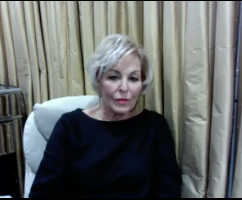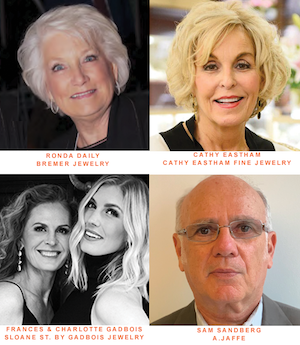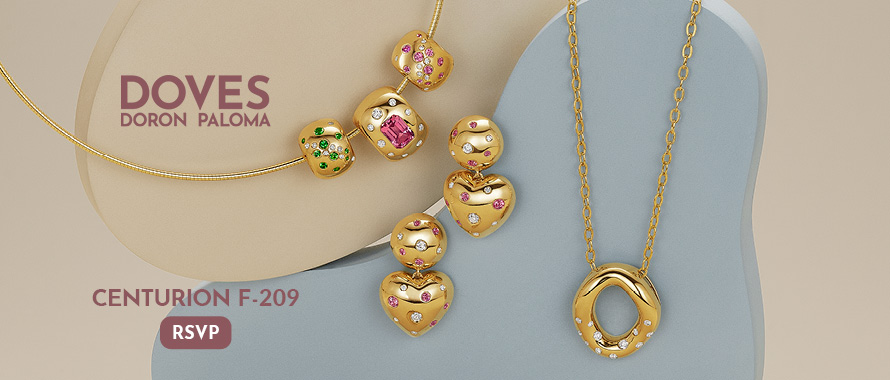Sales Strategy
Getting Back To Normal, Part 3: Housekeeping, Free Bracelets, And The Future Of Digital Selling | September 02, 2020 (0 comments)

Merrick, NY—Our Jewelers Getting Back To Normal series continues this week with a look at how jewelers used the time during spring’s pandemic lockdowns to better position themselves for success—including painting the store—and how quickly the industry has not only adapted to but actually embraced the digital world. Missed the first two installments? Click here for Part One and here for Part Two.
Panelists for this discussion were jewelers Ronda Daily of Bremer Jewelry, Bloomington and Peoria, IL, and Cathy Eastham (image at top) of Midland, TX. They chatted with vendors Frances and Charlotte Gadbois of Sloane Street, Newport Beach, CA, and Sam Sandberg, chairman of New York-based A. Jaffe. Centurion president Howard Hauben moderated.
Howard Hauben: How did you use your time while you were closed? How was business?
Ronda Daily: Bremer was closed from March till the end of May. I did a lot of housekeeping—the things you put off—while trying to train the staff at home. I even painted the kitchen at the store!
Cathy Eastham: We were concentrating on social media, doing a lot of Instagram, phone calls, texting. We were delighted with the response! While we were closed, we were able to get our website completely full of all the jewelry in the store. We had some, but it takes so much time to get it all. Now we’re able to present everything in the store online and we’ve had several big online purchases.
Frances Gadbois: I was in Europe and got home just before the lockdowns started. Charlotte and I both had COVID. We were sick the first two weeks of lockdown but we stayed in quarantine and none of the staff got it. There was no testing at the time but we both recovered great. [After lockdown] everyone worked from home, and we did a lot of housekeeping. We went through all our inventory and procedures and we put in a new software program.
Sam Sandberg: We were super-busy, redesigning the website, working on new technology like CAD and hologram, and really focusing on more customization to offer to independents.
Hauben: What are some specific initiatives you did? What came in above or below expectations?
Daily: We did a lot in those months. We called all the people who had layaways and special orders. We had a lot of things backlogged that people hadn’t picked up, so that kept our numbers up in March and April. We did a really interesting social media [program] where we raised almost $5,300 for a local food bank with a stretchy little bracelet from Dee Berkeley in Las Vegas. That was a big undertaking. We had no idea we’d sell almost 300 bracelets! We thought we’d sell maybe 50, so it was crazy!
Now we’re doing one with Easter Seals locally with another 250 bracelets, and our park districts contacted us, so I feel like this gave us an opportunity to let people know that even though we sell beautiful, well made, high price things from companies like Hearts On Fire and A. Jaffe and other high lines, we also have things for $50. That was a good marketing tool for us.
Before we went back, we wrote procedures for what we’re going to do when a guest walks in the store, and we’ve had to address how comfortable the staff is coming back and do they have child care, etc., all that stuff. How our staff feels is really important. And what if child care isn’t open or won’t be till there’s a vaccine? Even my daughter has a two-year-old!
Hauben: The team is so important! Mark Cuban said the other day that what we do now in terms of our team in a crisis will define our company for years to come. It builds the character of the business and it’s phenomenal.
Eastham: For the months of April and May we offered 20% off storewide and online, which was a positive thing for us. The day we reopened, we had balloons all outside the front of store. It was festive and inviting for people to come in. I tried to stay very involved in the community. Our local CBS station asked me to do a short video about being positive that they’ve been playing which has been a great boost. There’s so much now to be sad about that it’s up to all of us to be as positive and happy as we can.
C. Gadbois: We wanted to stay connected to our stores. We built a state-of-the-art custom design studio and connected via Zoom. We had online happy hours, just letting people know we’re there for them. We also did a lot of housekeeping as well, putting in some systems, and did a little bit of a push on Instagram as well.
As jewelers, there’s not much you can do for the healthcare industry so we do what we know. We did a giveaway for healthcare workers with some bracelets and hand-written notes from Frances and I. It was so inspiring to read the stories of the people nominated, doctors and nurses. It was a little thing for us but made such a difference to them. We delivered over 300 to local hospitals.
F. Gadbois: We have some of the same issues Ronda does—employees with child care—so we might end up with kids in the office as the new normal.
Sandberg: We were very busy. All our salespeople were working with store associates they have relationships with, doing training and getting new product ideas. We did a joint presentation with Estee Lauder live on Instagram that went really well, offering our A. Jaffe Maps. They’re available on our website at a 20% discount with an exclusive code through a participating independent retailer. The results were tremendous in only a half-hour presentation. It’s a way to build up the brand and connect the customer to our bridal, the focus of our business.
Something else we’ve been building and training on is our eternity [ring] program. It’s been a terrific success for us. Everyone has tried to sell eternities or use them as vehicle to move diamonds they may have bought locally or have in inventory, but we’ve turned it into a brand category. It lends itself particularly to customization and the tickets are really high!
Even in these times, [jewelers] have sold $25,000 and $30,000 pieces. It’s comparable to selling a much larger diamond but at a much larger margin. That’s a program we’re expanding and doing a lot of training and working to customize.

Hauben: Do you believe that hereafter you’ll be able to sell more online or get more business from digital?
Eastham: Yes, I believe we are going to get more business online and I’m really proud of that, but I really like one-on-one and having people come in. So many of our clients are our friends and we like seeing them and they like seeing us. There’s the chit-chatting and trying it on and just looking at everything in the store. I like online, but my preference is for people to come in the store, period.
I do see a future in online, though. What’s exciting for us is Instagram. I’m shocked at how much response we’re getting! We have a pro working on Instagram, Caroline—my right arm who works for me—has done an amazing job and people are really engaged with it. We’re getting calls from people who’ve seen things on Instagram. I’ve been at this a long time so all this Instagram and online is a little foreign for me, but I’m adjusting and I’m liking it. I always like when we have a sale! Any time we do, that’s celebration time.
Daily: Like Cathy, I still prefer to meet in person, but the key is this: as retailers, we need to meet people where they want us. Whether that’s text message, telephone call, email, curbside, delivery to home, in-store privately or in-store when we’re open. We have to meet our guests where they want us to be. That’s going to be a big change for many retailers and many of my friends.
We have our website through Punchmark which is attached to The Edge. We’ve got that continuity between the two, so we can put up our products sooner. [We added] a text chat feature on our site. People say ‘hey, I saw ABC on your site, do you have it, can I come get it?’ It’s kinda been a little shocking to us!
A wise man--Howard--asked a few years ago if we’ll do 25% of our business online in five years. I thought maybe not 25%, but we had to do something against Blue Nile and those places. But I believe going forward we will do more business online than ever.
Hauben: Vendors, can you talk a little bit about visual training and the mood of your customers?
C. Gadbois: Hearing this conversation about digital makes me laugh because it’s a conversation that’s been circulating for a while. As a tail end of Millennial, I keep hearing “damn Millennials and their social media,” but I think as an industry we’ve been lagging slightly on the social media front. For us, we’ve jumped into virtual trainings and such, and people are more comfortable with it than ever before because now mom and dad are getting together with Nana and Pop on Zoom.
F. Gadbois: We started doing virtual [meetings] before now because we’ve needed more time in the studio and less time on the road. Charlotte was a broadcast major so she has come into her own in the past few months applying what she learned in school. We got some extra equipment in the studio to do our Zoom meetings, she’s also been doing Instagram takeovers, and we’ve done one or two custom appointments with clients a week. All those retailers the past who’ve said, ‘oh no, why don’t you come to the store, we really don’t like digital,’ they’re now comfortable with it and I think the clients have liked it too. The retailer can see what’s going on with clients, and the client doesn’t have come into the store.
Everyone’s realizing it’s a great concept, and we can do a lot of great business without having to get on a plane. Our clients are a little bit older and were terrified of using it, but now they’re Zooming with the grandkids and are comfortable with it. I think it will continue!
Sandberg: The mood is inspiring. There’s determination to succeed. I see it with everyone, whether owner or key associates. I’ve been in the industry a long time and seen a lot of crises, and there are winners and there are losers. The difference comes down to character and vision. Character is the will to do the right thing and the smart thing. The vision is willingness to experiment and see what works and doesn’t work. It’s not about prophesy vision, it’s about being open to experimentation and taking one step backwards to take two steps forward.
Our lifeblood is our relationships with our retail partners. What’s the point of our website? To make it easier for retailers. Technology is going to evolve a lot more and it’s not going to be just about Zoom. We have to be very collaborative. We’re not as close to the consumer as Cathy and Ronda are. You have to keep us alert and updated and relevant to what’s going on, and what we need to do. Our success depends on your success.
C. Gadbois: It’s just the jumpstart I think was needed. I think on the whole it’s a silver lining and a positive. This is a tough situation, but I think everyone’s going to be better on the back end.
Sandberg: This is a good industry. It’s not bogged down in bureaucracy, it’s got good employment history, there’s not a lot of litigation from one end to the other, so if you look at it through crises, it always ends up ahead of where it was after a crisis. I’m very confident it will be here. It’s not going to be an easy road but it’s going to be an adventurous road.






